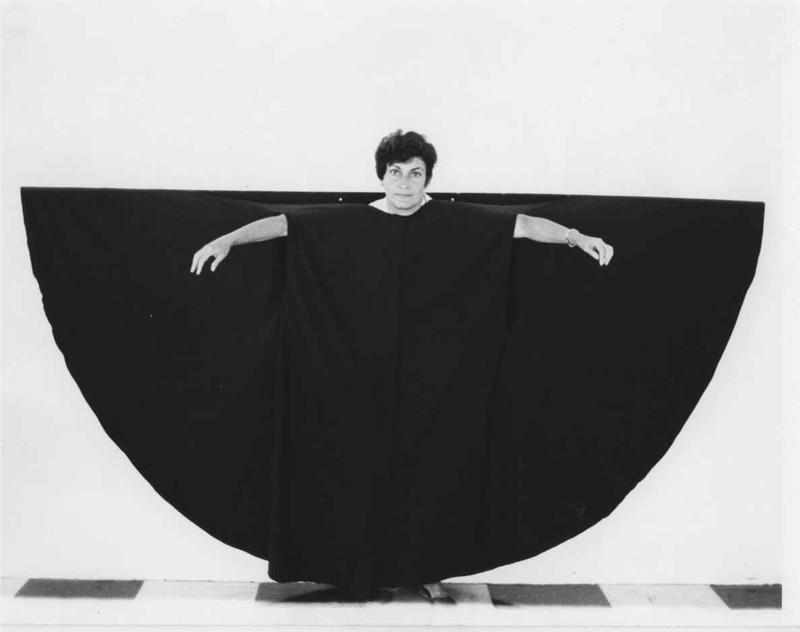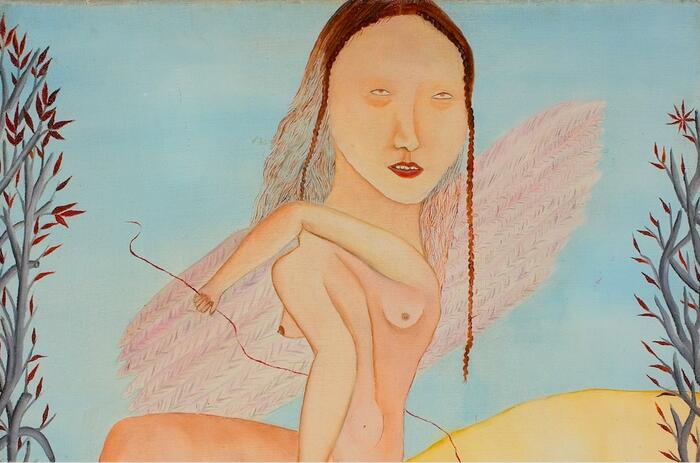RADICAL WOMEN
The extensive exhibition at the Hammer Museum, LA, California, has involved a remarkable effort to re-inscribe and rewrite the history of art with the radical (a term that in Spanish is also synonymous with primordial, essential) work of 120 women pioneers of the artistic experimentation in 15 countries, including the United States. Save for notable exceptions, Latinas and Chicano women artists have been—in bleak measure—hardly visible, and even less understood and studied.

The cover of the catalog is a detail of one of the photographs that make up the polyptych of Lenora de Barros Poema, 1979: A “close up” of a feminine mouth showing her tongue. The choice of the image as a threshold to this catalog of creators who built autonomous languages and multiple modes of resistance is perfect: the defiant act of sticking out one’s tongue precedes to that of licking the keys of a typewriter, and raising them with the female tongue until they adhere to the taste buds, as in an erotic act of knowledge, to finally construct with each transformed letter alternative and provocative forms, a narrative never before told like that. With a language without constraints, a deep conviction, the rare bravado to name everything that needs to be enunciated, Cecilia Fajardo-Hill and Andrea Giunta devoted eight years of their lives to this unparalleled research by its nature and dimensions, to start building a conmprehensive vision of radical artists, whose experimental practices were oftentimes connected to politics since they were created during a convulsive time. Such was the case of pioneers Cecilia Vicuña, Margarita Paksa, or Sonia Gutiérrez, among many other creators of art as an answer to political and social repressions. The catalog—just a chapter of an effort that could take up an entire lifetime—is a valuable overview, grouped by country, with 10 essays of other curators connected to the contextualization and revision of nine themes articulated to the central concept of the political body: “Self-portrait,” “The Body as Landscape,” “’Performing the Body;” “’Mapping’ the Body;” “Resistance & Fear;” “The Power of Words;” “Feminisms;” “The Social Space;” “The Erotic-.”
Save for notable exceptions, Latinas and Chicano women artists have been—in bleak measure—hardly
visible, and even less understood and studied
Fajardo-Hill explicitly states a difference between the catalog, a compilation as vast as incisive, and the exhibition museography: “In the rooms we did not conduct an academic exercise. The display–which can be seen on the website of the museum–was that when you walked among the works, your own body would be politicized, and somehow surprised and deeply touched by the exercises of these artists.” Inspired by the architectural proposals of Lina Bo Bardi, they created a non-linear display, as “a great organic body deploying shared stories.” Fajardo-Hills said: “We did not comply to the order of the decorative, but to the intensity of the information we wanted to offer, without hierarchies.” She recalls that Liliana Porter (one of the radical artists) and Ana Tiscornia described the experience of the tour “like a great chorus, at the same time, like a great forum.”
-
Feliza Bursztyn (Colombian, 1933–1982), Cama (Bed), 1974. Assemblage with stainless steel scrap, cot, satin sheet, and motor. 43 5/16 × 70 7/8 × 27 9/16 in. Museo Nacional de Colombia. Artwork ©the artist. Photo ©Museo Nacional de Colombia / Andrés Mauricio López. / Ensamblaje con chatarra de acero inoxidable, cuna, sábana de satén y motor. 110 × 180 × 70 cm. Museo Nacional de Colombia. Obra de arte © el artista. Fotografía © Museo Nacional de Colombia / Andrés Mauricio López.
-
Liliana Porter (Argentine, b. 1941), Untitled (Self-portrait with square), 1973. Gelatin silver print made from the original negative. Image: 16 1/4 × 11 in. Sheet: 20 × 16 in.
Courtesy of the artist. ©the artist. / Impresión en gelatina plateada hecha del negativo original. Imagen: 41.3 × 27.9 cm.; hoja: 50.8 × 40.6 cm. Cortesía del artista. © el artista.
-
Sandra Eleta (Panamanian, b. 1942), Edita (la del plumero), Panamá, 1977. Fom thecseries La servidumbre, 1978-79. Black-and-white photograph. 19 × 19 in.. Courtesy of Galería Arteconsult S.A., Panama. ©the artist. / Fotografía en blanco y negro. 48.3 × 48.3 cm. Cortesía de Galería Arteconsult S.A., Panamá. © el artista.
The image of an erased past that emerges and questions the great narrative in the history of art, marked by hegemonies from north to south, by unspoken exclusions that run even deeper when, in addition to the condition of Latinity, other factors such as gender and migratory movements, returns to contemporaneity with a mode of resistance that blurs the differences between celebrated and forgotten creators, or those not sufficiently recognized by a system of power outside the rhythms of the lives of women. The biographies written in alphabetical order ignore the lapses of time without exhibitions, one of the arguments of the exclusion. For example, such as in the case of the Colombian Sandra Llano-Mejía and the Chilean Sylvia Palacios Whitman, residents of New York. The first, a Hispanic pioneer of video art connected to technology and her own body, and the latter, to hybridizations between dance, drawing and performance. Or to that of Sara Modiano or Feliza Burstyn, who disappeared without a full recognition of their pioneering contributions. There are also iconic figures such as Argentina’s Liliana Maresca who died of AIDS at the age of 43, after having shifted the coordinates of contemporary art, the concept of authorship, and her communication not only with other disciplines but with life and society.
Liliana Porter (una de las artistas radicales) y Ana Tiscornia describieron la experiencia del recorrido “como un gran coro y, al mismo tiempo, como un gran foro”
The exhibition is defined as “the first genealogy of artistic practices radicals and feminists made in Latin America and by Latin artists” and includes emblematic figures such as the Mexican Monica Mayer—co-founder of Polvo de Gallina Negra along with Maris Bustamante—whose “super feminist” commitment in “the battle of the genres” and extreme transgression, initially turned it into “anathema.” The truth is that not all of the included artists identified feminism and political art, but they did contribute with their performances, video art, conceptual photographs, and other means to found a contemporaneity in their countries that has in common, with the exhibition, the adjectives with which Fajardo- Hill describes it: “a bit dirty, contaminated.”
Fhe first genealogy of artistic practices radicals and feminists made in Latin America and by Latin artists
Lygia Clark, whose neo-constructive abstract work is acclaimed, contaminated the geometry with creations of interactive healing rites which still feel uncomfortable. Magali Lara made her wonderful, Ventanas with words and daily traces and faces of women; Karen Lamassonne portrayed in her series, Baños, women sitting on toilets; Marie Oresanz stained her forehead with the word “limited” in the Argentina of the late 70s; Catalina Parra was contaminated in Imbunches with the seams and myths about the evil of the Mapuches in the Chile of that same decade; María Elvia Marmolejo made art with her Ritual de la menstruación, and Silvia Gruner her own Desnudo descendiendo en fotografía, and in the same year Graciela Iturbide portrayed the Juchitán de las mujeres, including some Zapotecs with female costumes in drag. It is not possible to list all the voices of women artists who have crossed the boundaries, and those now summoned by Fajardo- Hill and Giunta. Both the exhibition and the catalog of Radical Women encourage a broader conversation to constitute a necessary map, whose first part has been traced with as much honesty as rigor in a vital process into which the curators poured their heart and soul. Hopefully, the chorus of “that great eccentricity”—as most of those pioneers created by challenging the centers of power—does not lead to any type of imposition. For the polyphony of transgressions cannot be homogeneous so that the women’s open mouths–as seen in Lygia Pape’s piece Eat Me, 1975, incessantly articulate choruses and forums. Including those voices that are different, such as declared non-feminist artists along with Latinas of all ethnic roots and walks of life; judged not for being minorities, but for the sheer contribution of their free creations.
-
Anna Maria Maiolino, É o que sobra (What is left over), 1974. From the series Fotopoemacao (Photo poem action), 1973–2017. Three black-and-white photographs.
25 5/8 × 61 7/16 in. overall (framed). Collection of A. M. Maiolino. / Tres fotografías en blanco y negro. 65 × 156 cm. En general (enmarcadas). Colección de A. M. Maiolino.
-
Lenora de Barros, Poema (Poem), 1979. Photo: Fabiana de Barros. Six black-and-white inkjet prints on paper. 8 3/4 × 11 3/4 in. each; 55 × 11 3/4 in. overall. Courtesy of Lenora de Barros and Galeria Millan, São Paulo. Fotografía: Fabiana de Barros. Seis impresiones en blanco y negro sobre papel. 22.2 × 29.8 cm. cada una. 139.7 × 29.8 cm. total. Cortesía de Lenora de Barros y Galeria Millan, São Paulo.
-
Lenora de Barros, Poema (Poem), 1979. Photo: Fabiana de Barros. Six black-and-white inkjet prints on paper. 8 3/4 × 11 3/4 in. each; 55 × 11 3/4 in. overall. Courtesy of Lenora de Barros and Galeria Millan, São Paulo. Fotografía: Fabiana de Barros. Seis impresiones en blanco y negro sobre papel. 22.2 × 29.8 cm. cada una. 139.7 × 29.8 cm. total. Cortesía de Lenora de Barros y Galeria Millan, São Paulo.





